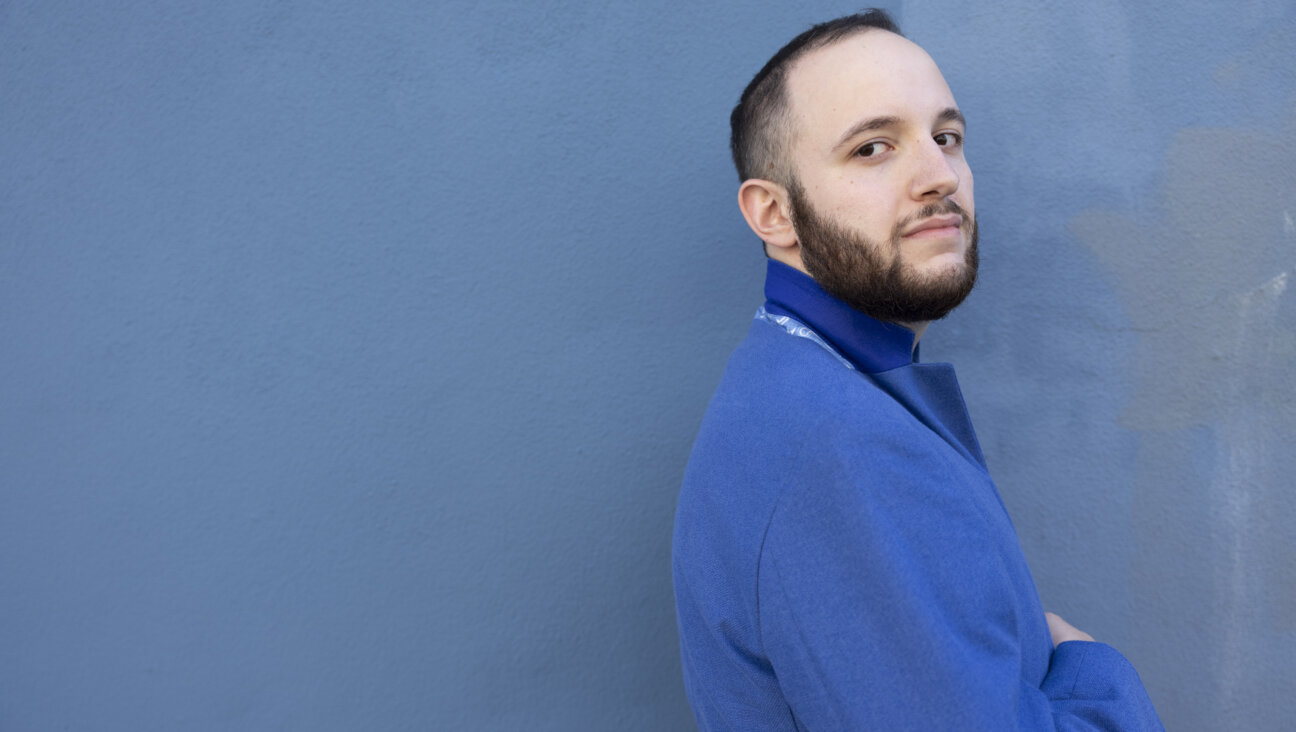Carine Goren: Israel’s Queen Baker

Graphic by Angelie Zaslavsky
The sunny smiling face of baking in Israel today indisputably belongs to Carine Goren.
Combining Martha Stewart’s mastery of pastry with Rachael Ray-style enthusiasm, she dominates the television screens as she prepares delectable desserts on her television show “Sweet Secrets.” That is also the title of her cookbook, which has been a mainstay of the bestseller list for years, and her recipes are passed around the Internet and frequently appear on Hebrew-language food blogs.
Her popularity created a demand for her recipes among English-speakers in Israel. So, last year Goren published her own translation of” Sweet Secrets,” which is available by mail-order in the US.
The desserts she creates are at once impressive and largely simple to make. Her ability to bring high-level baking to the home cook works well because she is self-taught. All of her recipes are developed in the house she shares with her husband Ronen, who left his own cooking career to manage his wife’s pastry burgeoning empire – which includes cookbooks, her television show, and a very active website and fan forum. They even photographed the desserts for her cookbook at home. (Full disclosure: as a family friend whose husband has assisted her with legal work, I have enjoyed eating the photo session “leftovers” more than once.)
Allison Kaplan Sommer: Yours was an unusual path to a career in pastry – you’ve never worked in a restaurant, a bakery or as a caterer.
Carine Goren: Until age 26, I didn’t do anything in the kitchen, I was simply not interested in cooking or baking. [Ronen] was such a good cook, I never even tried to compete. I was working in computers as a webmaster – a job which bored me to death. The turning point came when I got fired. I received about $1500 in severance pay, and on the same day I saw a brochure for a pastry course for beginners, which cost the exact amount of money. So I signed up for the 12-meeting class – Ronen cooked but didn’t bake, so I figured I would learn to make dessert.
From the first class, I fell in love, and I was hooked. I finally knew what I wanted to do when I grew up. I read every book on baking published in Hebrew, and when I ran out, I started ordering books in English, and in French. After the class, I began working in computer support at the food magazine and cookbook publishers Al HaShulchan. I would bring cakes to the office and everyone wanted to know how I made them. So that’s how I started writing and publishing my recipes.
What is it about baking that does it for you?
I come from the world of computers – a very structured world of rules. When I began baking, I found something in which I could be creative, but where there were still rules, still structure. Aside from that, obviously I like to eat well, and I love the pleasure that I bring to people with the things that I bake and the pleasure that comes from teaching.
You make desserts from around the world. What is special about Jewish and Israeli baking?
I think there is a lot of inspiration in the Jewish holidays, developing special recipes for desserts once a year – apples and honey on Rosh Hashanah, dried fruit and nuts on Tu B’Shvat. In Israel, we do a lot of creative things with doughnuts – sufganiot – because we eat them once a year on Chanukah and not all year round.
Israeli baking is, of course, influenced by the local ingredients – techina, *silan (date honey syrup), halva and spices from Arab region like cardamom. In Israel, you find desserts that could only come from a country that is a real melting pot of immigrants – desserts that can combine Bavarian cream with ingredients you would only find in the Middle East.
Let’s talk about your relationship with halva, you use it often in your recipes.
Halva isn’t an ingredient – it’s an addiction, a disease. I am totally in love with it. And I love how it combines with other ingredients – I have a recipe for chocolate and halva babka – and a dessert I developed with layers of halva, tehina and silan layered in pastry. On my television show, I even did a segment on how to make halva. But that’s deadly – you make it, and it’s sitting out there on your kitchen counter all day. You can’t stay away.
Making halva at home – that sounds challenging.
Actually, it’s not difficult at all. Really, it just involves combining sugar and tehina.
Are there a lot of baking trends in Israel, or do people like traditional items?
In the Tel Aviv restaurants, where the chefs aspire to follow international trends, they are experimenting with the current gourmet trend of desserts that have salt and unusual spices.
That’s not really for me. I have simple tastes, and I am very oriented to the home cook. Some chefs look down on me because I include ingredients in my recipes like petit beurre biscuits or instant pudding. Overall, I try hard to develop recipes with ingredients people can find in any supermarket – show that from the simplest materials, they can make a really impressive dessert.
Also, for me, desserts are to a large extent about childhood and nostalgia. I like to vary and play with recipes, but with a great deal of respect for an original.
Which do you enjoy more, recipe development or being on television?
It depends on what day you ask me. Right now I am working on a new cookbook, which is both incredibly fun and terribly frustrating, as cake after cake goes into the garbage as I try to get it exactly right with my obsessive personality.
What are your favorites from overseas?
I haven’t been to the U.S. yet, but I am a huge fan of American baking and I prefer it to the European traditions. I love the sweetness, the generous portions, the cupcake trend. I buy every baking book that comes out in the States. When I went to Paris, the pastries looked like jewelry to me – too pretty and delicate to eat. In Great Britain, I love and can relate to Nigella Lawson her sensuousness, home-cook orientation, and how much she enjoys food.
How does a pastry chef handle the trend towards healthier eating? And while we’re on the subject, I’m sure you are constantly asked how you manage to keep your figure in your line of work?
In my new book, I have developed sugarless versions of each recipe for those who want to bake without sugar. Regarding low-fat and low-calorie desserts, I’m trying, but unfortunately I haven’t gotten there yet – so far, I haven’t discovered a brilliant dessert recipe using rice cakes. But also, I don’t believe one slice of a good cake will destroy anyone’s diet. All things in moderation.
As for me, the only justification I would have for possessing the chutzpa to complain about my life, it is in this department. Controlling my weight is a war. I yo-yo – when I am not filming my show, I allow myself to eat desserts and my weight goes up. Then, when I know I am going to go on screen, it’s two months of lettuce. When I work during this time, I allow myself one bite of each dessert I make.
What is your most requested recipe? What is your favorite?
Everyone loves my spiral [cheese]cake. People come up to me in the street to discuss that recipe. It makes an impression – it looks very complicated and sophisticated to make, but it is not. If I had to choose my favorite dessert, it would be brownies – I told you I had simple tastes. I have developed many variations – one with small squares of halva inside. Yum!
Where would you send a tourist with a sweet tooth in Israel – presuming they aren’t lucky enough to find your kitchen.
I would send them to a wonderful bakery called Ben-Ami – an amazing bakery. They have a red grapefruit and pear tart to die for. We have amazing fresh fruit in Israel. I need to develop more recipes with fruit. I have several, but overall, I’m too much of a sucker for whipped cream and chocolate. And, of course, halva.
Chocolate Catastrophe Cake
Here is your next diet-breaking excuse: a chocolate cake that is a disaster to the thighs but a great joy to the soul! Eat it straight from the refrigerator and it is dense and slowly melts in your mouth, like a rich chocolate truffle. Eat it at room temperature and it tickles the tongue with fluffy clouds of baked chocolate mousse. Either way–you cannot stop eating it. Try it and you will see why.
7 eggs, cold
¾ cup sugar
14 ounces bittersweet chocolate
¾ cup plus 2 tablespoons (7 ounces) unsalted butter
3 tablespoons coffee liqueur (or any other liqueur you prefer)
One round 9-inch baking pan
1) Preheat the oven to 150ºC/300ºF. Place a deep pan on a low rack in the oven and fill with boiling water (to create a steamy environment). Line the baking pan with parchment.
2) In the bowl of a mixer, whip the eggs and sugar on high speed for 8 minutes, until thick and pale in color.
3) Meanwhile, melt the chocolate and butter together. Beat 1/3 of the egg mixture into the melted chocolate mixture. Fold in the liqueur. Fold the remaining egg mixture into the chocolate mixture until evenly combined.
4) Pour the batter into the pan and bake for about 55 minutes, until the surface cracks slightly and the cake is barely firm. It will not look completely baked, which is fine. Cool thoroughly. Refrigerate for at least 4 hours.
5) Keep refrigerated. Slice with a knife dipped in boiling water (wipe and dip between each slice) and serve cold or at room temperature.
SWEET SECRET: As a rule, I recommend using eggs at room temperature in recipes; but not in this one. Here, the eggs are used directly from the refrigerator. Why? Eggs whipped at room temperature produce a fluffy, airy mixture, and the cake turns out light and creamy (in this case, too light). When eggs are whipped cold, the result is dense and somewhat viscous; giving the cake a rich, dense and creamy texture.















